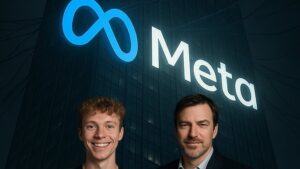Meta’s Bold AI Talent Move: Hiring More OpenAI Researchers
1. Setting the Stage: The AI Talent Wars Heat Up
In mid-2025, Meta escalated its hiring strategy, aggressively wooing elite researchers from OpenAI to bolster its AI ambitions. This came against the backdrop of a fierce AI arms race—tech giants like Meta, Microsoft, Google, and more poured billions into talent, infrastructure, and AI research to compete for dominance in artificial general intelligence (AGI) and superintelligence New York PostInvestopediaFinancial Times.
Meta’s broader recruitment spree and AI push included acquisitions like a 49 percent stake in Scale AI for $14.3 billion, bringing aboard that company’s CEO, Alexandr Wang, to lead Meta’s newly formed Meta Superintelligence Labs (MSL) India TodayThe InformationWikipedia.
2. The OpenAI Exodus: Key Researchers on the Move
a. Early Poaching Waves
Initial reports confirm that Meta hired three OpenAI researchers—Lucas Beyer, Alexander Kolesnikov, and Xiaohua Zhai—from OpenAI’s Zurich office to strengthen its superintelligence initiatives Business StandardTHE DECODERTechCrunch.
This was followed by the hiring of four additional OpenAI researchers: Shengjia Zhao, Jiahui Yu, Shuchao Bi, and Hongyu Ren—notable AI model developers who contributed to GPT-4.x internals, multimodal processing, and reasoning models like o1-mini and o3-mini The InformationTHE DECODERmint.
Altogether, this accounts for at least eight high-profile researchers departing OpenAI for Meta in a matter of weeks mintBusiness Standard.
b. A Broader Talent Blitz
This hiring wave wasn’t limited to OpenAI. Reports suggest Meta recruited 11 top-tier researchers from rival labs, including OpenAI, Anthropic, and Google DeepMind—forming the initial core of its Meta Superintelligence Labs (MSL), co-led by Alexandr Wang and Nat Friedman India Today.
3. Why This Matters: Motives Behind the Moves
a. Self-Inflicted Pressure and AI Lag
Meta’s own Llama 4 launch underwhelmed expectations, prompting Zuckerberg to react strongly. He not only upped investment and acquisitions but personally led recruitment campaigns, even hosting potential hires at his home The InformationWikipediaIndia Today.
b. Chasing the AGI Dream
Meta’s creation of Meta Superintelligence Labs signals its renewed commitment to achieving breakthroughs in AGI. The operation consolidates model research, product teams, and FAIR under one ambition—delivering “personal superintelligence for everyone” India TodayDecryptWikipedia.
c. The War for Elite AI Talent
With traditional acquisitions hitting regulatory roadblocks, companies increasingly pursue “reverse acquihires”—snapping up talent instead of entire firms The Wall Street Journal. Meta’s lavish offers—speculated to include packages of up to $100 million or even $300 million over several years—underscore the premium placed on researchers with proven track records The Times of IndiaNew York PostInvestopedia.
4. Fallout at OpenAI: Internal Response and Retention Moves
OpenAI sensed the encroachment. Mark Chen, Chief Research Officer, warned staff that it felt “as if someone has broken into our home” and announced efforts to recalibrate compensation to keep talent from jumping ship Business Standardmint.
Sam Altman publicly criticized the bo plus claims—calling them “crazy”—though Meta leadership countered that such offers applied only to senior executives TechCrunchNew York PostTHE DECODER.
5. Industry-Wide Ripples and Ethical Dilemmas
a. An Escalating Talent Arms Race
This talent drama reflects a larger pattern—Massive pay packages (sometimes tens of millions) became a standard offer for elite AI researchers, altering compensation norms and raising equity concerns InvestopediaMoneycontrol.
b. Startup Ecosystem Strain
Smaller startups report losing founders to Meta-level packages—like a 24-year-old AI prodigy accepting a $250 million offer. This raises fears about talent concentration and undermining innovation diversity The Times of IndiaWikipedia.
c. Ethics of Poaching
Critics argue such aggressive talent moves risk monopolizing top minds in a few tech giants, stifling broader innovation and fostering an unsustainable model where loyalty and culture no longer matter as much as cash Top AI Tools List – OpenToolsThe Wall Street Journal.
d. Public and Peer Pushback
Demis Hassabis of DeepMind called Meta’s tactics “rational”—saying it’s trying to catch up—but stressed that many researchers prioritize ethics and mission over pure financial gain IT ProBusiness Insider.
6. What Meta Gained — And at What Cost?
a. Talent for Tomorrow’s Models
Meta injects its ranks with researchers who helped power key models like GPT-4.x and reasoning-multimodal architectures. That is a substantive boost for its LLM roadmap and new superintelligence efforts.
b. Organizational Shakeup
The consolidation of multiple AI divisions under MSL aims for cross-discipline collaboration. Wang leads as Chief AI Officer, with Friedman driving product application, suggesting re-energized strategy India TodayWikipedia.
c. Internal Friction
Such moves sparked discontent within Meta: long-time employees feel overshadowed or undervalued, and some threatened to leave or bargain for better roles in MSL Business Insider.
7. Broader Impact on AI Research Dynamics
a. Redistribution of AI Talent
This isn’t just a battle between Meta and OpenAI—Microsoft, Anthropic, Amazon, Deepmind, and startups all are part of the high-stakes scramble. It has redrawn the talent map across the industry Windows CentralFinancial TimesIndia Today.
b. Compensation Norms Shift
Average pay for senior AI researchers skyrocketed—now regularly in multi-million-dollar ranges—not only for senior titles but across elite research roles MoneycontrolInvestopedia.
c. Innovation Risk
If top researchers gravitate only to giants like Meta or OpenAI, smaller firms and academia could suffer brain drain. Critics argue that a thriving ecosystem requires diverse institutional players The Wall Street JournalTop AI Tools List – OpenTools.
8. The Human Side: Choosing Beyond Money
Despite the lure of big paychecks, many researchers remain motivated by mission, research freedom, and values. Cases like Thinking Machines Lab—started by ex-OpenAI CTO Mira Murati—suggest culture still matters The Wall Street JournalWikipedia.
Indeed, several defected Meta recruits reportedly resisted financial incentives, citing concerns about mission alignment and research ethics The Wall Street JournalBusiness InsiderThe Times of India.
Summary Snapshot
| Aspect | Details |
|---|---|
| Who moved | At least 8 OpenAI researchers (plus others from Anthropic and DeepMind) joined Meta; notable names: Zhao, Yu, Bi, Ren, Beyer, Kolesnikov, Zhai. |
| Why Meta hired | To recover from AI model setbacks (Llama 4) and build its AGI infrastructure via its new MSL division. |
| Compensation packages | Reported offers up to $100–$300 million over several years; Meta disputes generalization of such figures. |
| OpenAI’s response | Internal compensation escalation, retention efforts, public pushback on recruitment tactics. |
| Ecosystem impact | Retooling of compensation norms, concern over talent concentration, new strategies to retain/start smaller AI ventures. |
| Human motivations | Cultural mission remains a core reason some researchers resist financial incentives alone. |
Final Thoughts
Meta’s hiring spree from OpenAI underscores how human capital has become the pivotal battleground in today’s AI revolution—more than just algorithms or hardware, it’s the researchers themselves steering breakthroughs.
This arms race is reordering tech’s talent landscape—but what remains uncertain is whether sheer financial firepower will sustainably fuel innovation or erode the diverse ecosystems and ethical guardrails that made early AI progress possible.
If you’d like, I can craft this into a polished publish-ready feature with SEO optimization, intros, headlines, and visual suggestions—just say the word.
https://bitsofall.com/https-yourwebsite-com-google-veo-genai-video-model/
What is Strong AI? Understanding the Vision of True Artificial Intelligence






